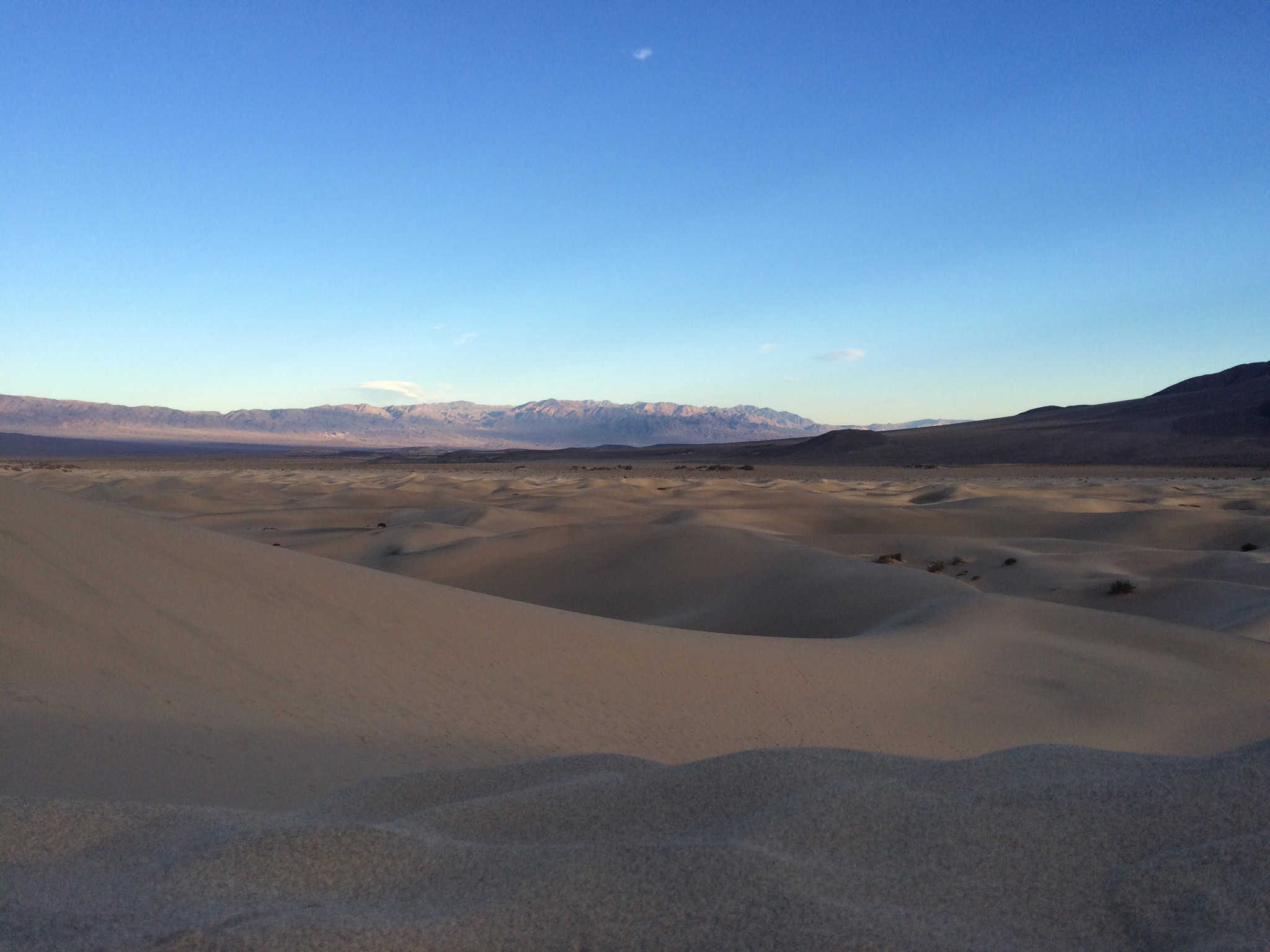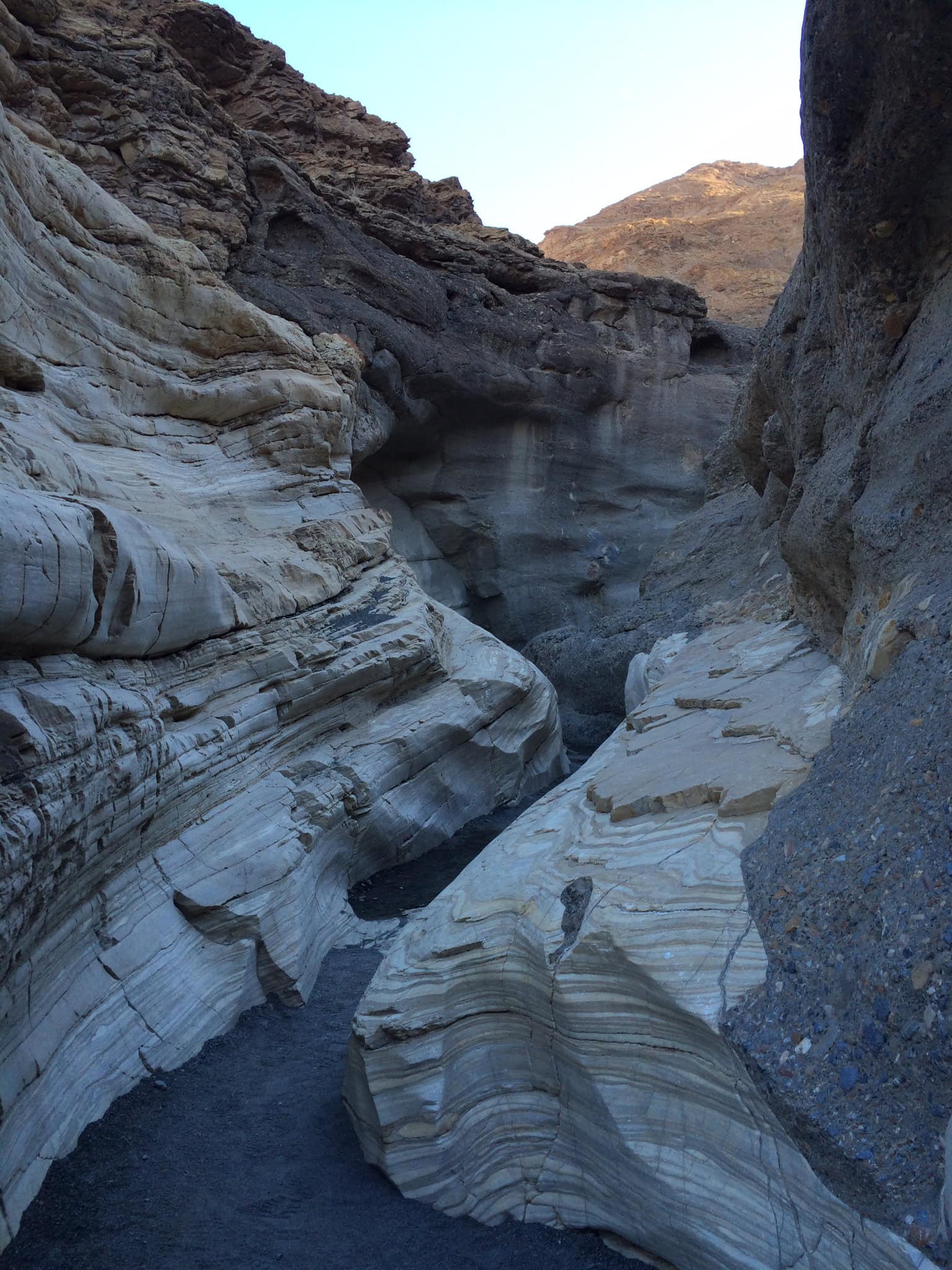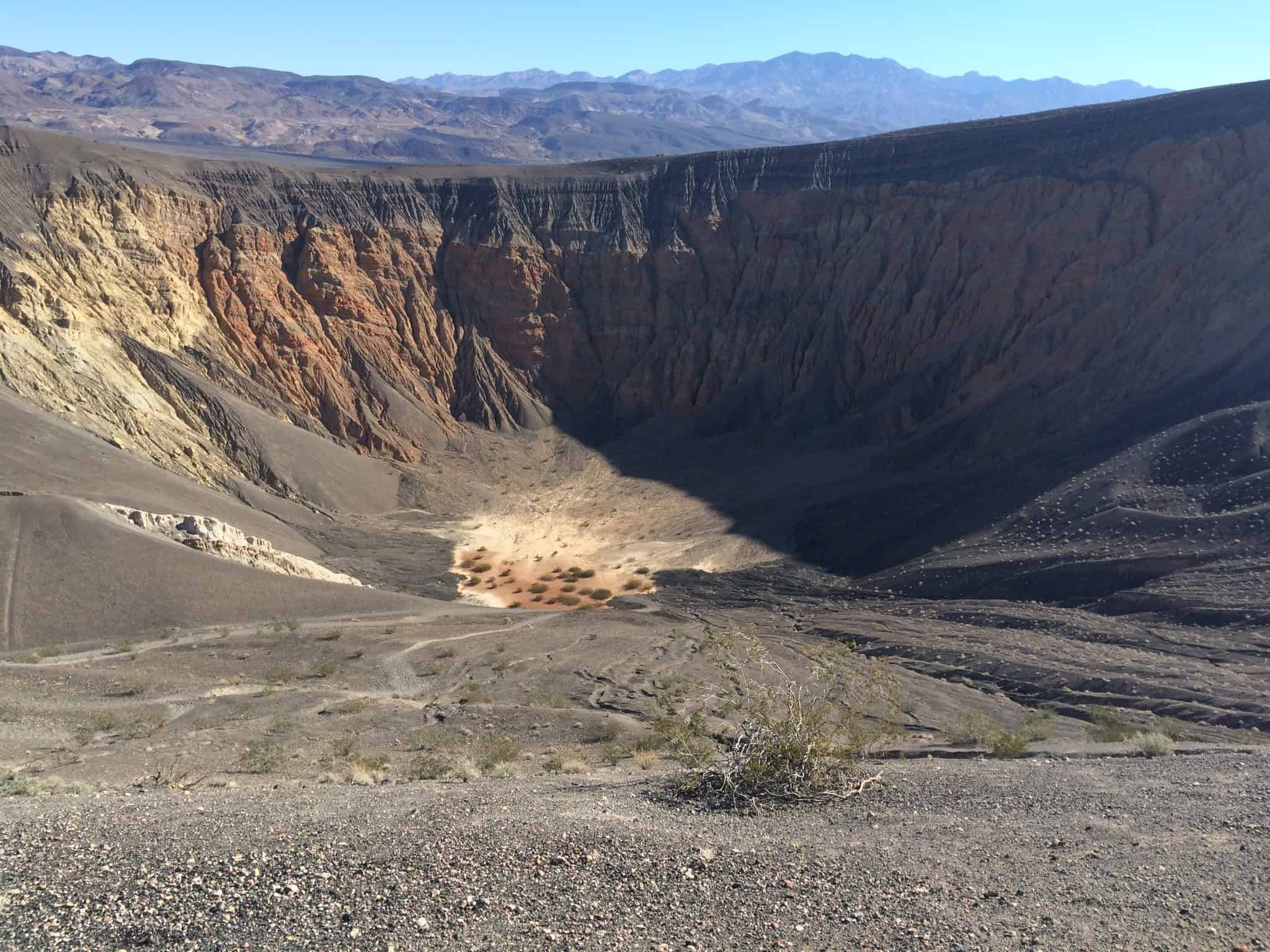Exploring Death Valley National Park was one of my most memorable experiences as a traveler and lover of unique places.
Even though Death Valley is famous for scorching temperatures, there is so much to see and do in this distinctive desert landscape that most visitors can suspend the unbearable heat for a few days. CT and I did that when we set out to see as much of Death Valley as possible in a three-day trip.

The most challenging thing about seeing Death Valley National Park in just three days is that it is enormous (5,270 square miles / 13,600 square kilometers) and situated in the remoteness of the expansive desert on the eastern side of Central California. The nearest large city is Las Vegas, Nevada.
Table of Contents
Getting To Death Valley

Driving to Death Valley National Park is a long process from Los Angeles and other Southern California cities. Plan on a nearly 5.5-hour drive over 280 miles (450 kilometers) from any of those locations, but it is only a two-hour drive from Las Vegas.
Day 1
On the first day, we left early in the morning to do some sightseeing before dark. We arrived at the Furnace Creek Visitor's Center around noon, and even though we took this trip in February, it was hot when we got out of the car.

Where to Stay
Death Valley National Park has hotels in various small villages scattered around the park, but the main entrance and visitor center are at Furnace Creek. Many of the most popular and accessible sites are near Furnace Creek, so it is an excellent place to stay if this is your first time at the park.
While many Death Valley National Park visitors arrive in recreational vehicles, sprinter vans, or tents to take advantage of the many camping sites, Furnace Creek has two hotels. We chose to stay in Furnace Creek at what is known as The Ranch.

We took a side trip up the hill to visit the crown jewel of hotels for hundreds of miles: The Inn at Death Valley. This four-diamond-rated resort has been serving tourists since 1927. Hollywood elites like Marlon Brando, Clark Gable, and Carole Lombard are on the historical guest list.
When we visited the Inn, it seemed like we had gone back in time. The hotel felt as old as it was, so we had drinks and dinner on the patio near the pool but chose to avoid the costly stay. A recent $100 million renovation has spruced up the place and added many more rooms and cozy casitas.
Hotels are Expensive
A quick check of the rates for staying in Furnace Creek revealed a wide range of overnight costs. On Monday, March 7, 2022, rooms or space were available at the Inn for $669, the Ranch for $319, and Fiddlers Campground for $29 per night.
If you choose to camp, Fiddlers Campground is adjacent to all the amenities at Furnace Creek Ranch, including the stores, gas stations, bars, restaurants, swimming pool, golf, and air-conditioned buildings.
Related: Anza-Borrego Desert State Park

Many of the dozen or so campgrounds in Death Valley are closed for the hottest months of the year. With little shade and rocky ground, a day at 120 F (48 C) is undesirable and unsafe. Check the official Death Valley website for dates and conditions before you go.
Mosaic Canyon

After arriving at the park and eating lunch at the Furnace Creek Golf Club Cafe, we checked into the hotel and set out for our first day of adventure.
We decided to hike into Mosaic Canyon, a short drive (36 minutes) from Furnace Creek. We learned very quickly that Death Valley is huge, and everything is far away from everything else.
The canyon is stark and almost uniform in color; the hike is about four miles round trip and begins as a broad, rocky opening on the side of the mountain. After a while, it narrows dramatically and even has some very skinny gaps to squeeze through to the end. It feels like I have been here before. As we turn a new corner, it looks familiar to me repeatedly.
Filming Star Wars

It turns out that Mosaic Canyon was used in the original movie Star Wars in 1977. As we hiked through the canyon, I could see the scenes in my mind where R2D2 wandered away from Luke into the canyon, where the Sand People later attacked them.
Every visitor to Death Valley should experience the short hike in Mosaic Canyon.
Mesquite Flats Sand Dunes

I have always loved climbing on and photographing sand dunes. Something attracts me to this remarkable geological feature. Many people mistakenly think Death Valley is all sand, but only about one percent of the park is covered in dunes.
Mesquite Flats Dunes are the best known and most accessible to visit in the national park. They're in the central part of Death Valley near Stovepipe Wells, a village with campgrounds and a hotel.
These dunes cover a wide area, and as the sun begins to set, we see very few people. We brought our headlamps to find our way back to the car, as it would be completely dark before long.

As the light fades and we find ourselves alone, we strip down to our birthday suits and run and jump around the dunes like we are little kids again. Such is the life of adventure and purposely found solitude. Once it is dark, we have lost our bearings and begin to wonder which direction to return to the truck.
There are a few moments of trepidation until we finally climb a very high dune, see a car's lights in the distance, and figure it's the road. With our lamps out, we climb up and down dune after dune in the dark, like sailors on a stormy sea with large waves, until we find our way back.
Related: Sandboarding in the Atacama Desert

Day 2
The Racetrack

I had wanted to explore the Racetrack in Death Valley National Park my entire life. The gigantic dry lake, mysterious moving rocks, and long, unexplained trails tracked into the hard lake mud are natural draws for travelers to Death Valley.
The drive from our hotel in Furnace Creek to The Racetrack is 83 miles or 134 kilometers each way. The last 18 miles are on a rocky, uneven road.
A display at the Visitor's Center gave dire warnings about driving on that road and the tire or suspension damage that could occur to your vehicle if you don't drive carefully or slowly. I scoffed at the information, thinking it was meant for someone else.
Ubehebe Crater

On the way to The Racetrack, we stopped at Ubehebe Crater to hike around its perimeter. While Ubehebe Crater is fantastic, I was anxious to get going and see the Racetrack dry lake.
The road is paved to Ubehebe, but from there on, a 4×4 vehicle with off-road tires is recommended. I wanted to get to the Racetrack quickly, so I drove up to 15 miles per hour. Not too far into the drive, our truck with street tires, going at those speeds, gave out.
Related: Hiking Diamond Head Crater in Hawaii

I floundered on the rocky and sandy road, trying to change to the spare tire for what seemed like hours in the oppressive heat and on top of some unhappy, stinging ants.
As I wrestled with the spare tire and jack, dozens and dozens of other visitors passed us, driving very slowly over the rocky road. I wish I had driven the same way. Lesson learned.
With the help of a Good Samaritan, the spare was finally on the truck, and the very present worry that we would pop another tire and be stranded forever began to set in.
We slowly headed back to Furness Creek and called it a day by swimming in the hotel pool. Regrettably, as of this writing, I have not yet returned to the Racetrack.
Day 3
We explored Badwater Basin, Artist's Pallet, and Natural Bridge on day three.

Badwater Basin
Badwater Basin is the lowest elevation in the United States, at 283 feet or 85.5 meters below sea level. The drive to Badwater Basin is only 20 minutes from our hotel in Furnace Creek. We are all alone when we arrive and quickly run out onto the crusty, salty, flat, dry lake bed.
Human traffic has packed a large area near the parking lot smoothly, but as we go further out onto the flat, it gets rough and strangely like a storm on a sea.

The vast lake bed covers over 200 square miles (518 square kilometers). In the distance to the east, we can see the snowy patches on Death Valley National Park's Telescope Peak, which is 11,048 feet (3,564 meters) high. It's one of the most dramatic rises in elevation, which can be seen simultaneously.
It is strange to think about how near places so high and so low in elevation can be to each other, let alone in the same National Park.
As diverse as the United States geography is, the lowest and highest points in the contiguous states, Badwater Basin and Mount Whitney, at 14,503 feet (4,678 meters), are only about 100 miles (160 kilometers) apart. Badwater Basin was incredible, and we started to feel the sting of missing the Racetrack ease off a bit.
Our early-morning arrival at Badwater Basin does two things for us — allow us to leave before it gets too hot and enjoy the peacefulness before two busloads of tourists arrive.
Artist's Pallet

A short detour from Badwater Basin is a one-way drive through some of the most colorful natural landscapes I've ever seen. The rock and dirt of the Artist's Pallet seem like a giant spilling his collection of paint all over a hillside. It is easy to get to and wonderful to look at.
Natural Bridge
Next to Artist's Pallet and Badwater Basin is a two-mile hike through an ancient river bed and around Natural Bridge, a carved rock feature.
The hike is easy but involves walking over sand and small gravel, which can be difficult without proper footwear. The most stunning rock feature is a natural bridge you can hike under, giving the hike its name.
Related: Bryce Canyon National Park in Utah

High walls on each side of the narrow canyon provide a great deal of shade, so we are pleased with a not-so-hot hike. The lower sun angles of our winter visit help with the heat in some of the canyon hikes, as the sun's rays often hit one of the canyon walls while the trail is still shaded.
Even so, everywhere we went, we took loads of cool water in our packs and kept a cooler of cold drinks in the car for our return. After our morning activities, we returned to The Ranch, packed up our gear, checked out of the hotel, ate a quick lunch, and started our six-hour journey home.
While we didn't get to everything we came to do in the park on this trip, we returned a few years later to climb Telescope Peak. That story will be in another post, but I can say that we will surely visit Death Valley again and again.
Exploring Death Valley National Park should be on everyone's list of places to go and things to do in the United States.
Traveler, Adventurer, Writer, Photographer
Planning a trip? Go Backpacking recommends:
- G Adventures for small group tours.
- Hostelworld for booking hostels.
